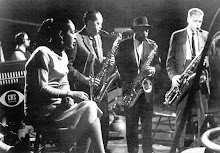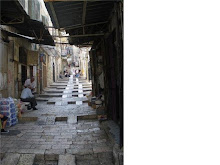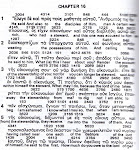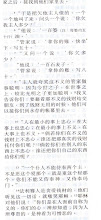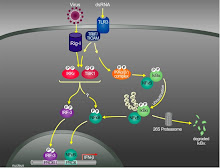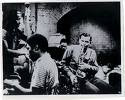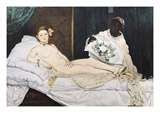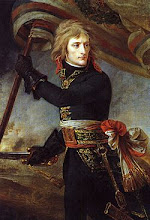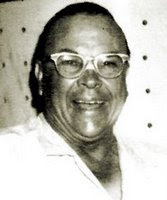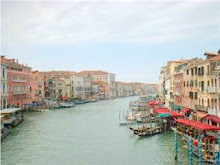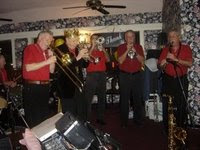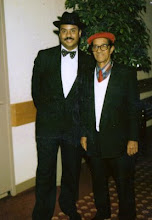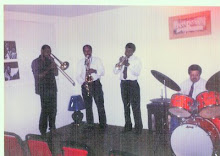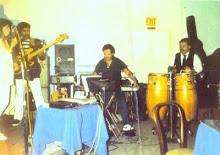Wednesday, July 30, 2008
Speaking of Cultual Activities
1004 NORTH San Jacinto @Wood
JAZZ JAM
8PM-12
WITH THE FABULOUS TERRY "T" THOMAS ON KEYS/BASS
AND AL MURPHEY ON DRUMS
EYE PEA (IP) @ NBA
Yet there was another school of thought directed at the election of Obama and the Voting Rights act enforcement necessitating 3-4 weeks of volunteer time for OBAMA
Wow where can I start. Well according to my relevance barometer which rules out BS, between the YOUNG Lawyers and the OLD Guard, the community as a whole is in better hands with the legal profession than with the medical. There was substantial rhetoric directed towards the particulates of powerlessness and the potential for restoration of the community. This is assumed to jeopardize the personal gain and recognition by peers. I wish the NMA had such a progressive and pro-poor stance. We just have not got out of self for the most part to talk about free care as the lawyers are talking about taking pro-bono cases. I guess there is a difference in the malpractice exposure.
After going to the Young Lawyer Section of the NBA and hearing about some of the people that had to be worked around, it is obvious that the mandate was for community from the jump. Thank God for each presiding member which continued the mandate set forth by the author of part of the history-JUNIUS W. WILLIAMS
Tuesday, July 29, 2008
NAPOLEAN

Battle of the Nile by Thomas Luny
In May, Bonaparte was elected a member of the French Academy of Sciences. His Egyptian expedition included a group of 167 scientists: mathematicians, naturalists, chemists and geodesers among them; their discoveries included the Rosetta Stone and their work was published in the Description of Egypt in 1809.[26] This deployment of intellectual resources is considered by Ahmed Youssef an indication of Bonaparte's devotion to the principles of the Enlightenment, and by Juan Cole as a masterstroke of propaganda, obfuscating the true imperialist motives of the invasion.[27] In a largely unsuccessful effort to gain the support of the Egyptian populace, Bonaparte also issued proclamations casting himself as a liberator of the people from Ottoman oppression, and praising the precepts of Islam.[note 5]
En route to his campaign in Egypt, Napoleon seized Malta on 9 June 1798. Requesting safe harbor to resupply his ships, he waited until his ships were safely in port, and then turned his guns on his hosts. The Knights of Malta were unable to defend themselves from this attack.
On 1 July, Napoleon landed successfully at Alexandria, temporarily eluding pursuit by the British Royal Navy. After landing he successfully fought The Battle of Chobrakit against the Mamelukes, an old power in the Middle East. This battle helped the French plan their attack in the Battle of the Pyramids fought over a week later, about 6 km from the pyramids. Bonaparte's forces were greatly outnumbered by the Mamelukes cavalry - 20,000 against 60,000 - but Bonaparte formed hollow squares, keeping supplies safely on the inside. In all, 300 French and approximately 6,000 Egyptians were killed.[28]While the battle on land was a resounding French victory, the British Royal Navy managed to win at sea. The ships that had landed Bonaparte and his army sailed back to France, while a fleet of ships of the line remained to support the army along the coast. On 1 August the British fleet under Horatio Nelson fought the French in the Battle of the Nile, capturing or destroying all but two French vessels. With Bonaparte land-bound, his goal of strengthening the French position in the Mediterranean Sea was frustrated, but his army succeeded in consolidating power in Egypt, though it faced repeated uprisings.[29]
IS THERE ANY DOUBT WHERE HE AND CARLOTA ARE NOW?

Maximilian, Emperor of Mexico 1832 - 1867
Ferdinand Maximilian Joseph, Archduke of Austria, became Emperor of Mexico when Napoleon III sought to extend French imperial power. Assured a French army, and believing that his appointment had a popular base, the idealistic young aristocrat and his wife, Carlota, were crowned in Mexico City on June 10, 1864. Almost immediately, Maximilian's policies antagonized his backers, as he upheld Benito Juarez's land reforms, educated the Indians and the poor, and encouraged Confederates to immigrate to Mexico. Too late, he acknowledged that his government was bankrupt. By the spring of 1865, the venture had failed. But when the French finally left Mexico in March 1867, Maximilian remained behind, refusing to desert "his people" when Juarez and his army returned. Two months later, Maximilian was court-martialed, condemned to death, and executed.
This photograph was made by Brady's operator Andrew Burgess in 1864. Brady had sent Burgess to Mexico that year to record the impending struggle. Burgess remained there for several years, assembling documents of the French occupation as well as portraits of the Emperor and Carlota.
Clusters of Differentiation/CD
CD34 molecule is a cluster of differentiation molecule present on certain cells within the human body. It is a cell surface glycoprotein and functions as a cell-cell adhesion factor. It may also mediate the attachment of stem cells to bone marrow extracellular matrix or directly to stromal cells. CD34 is the human gene encoding it.[1]
Cells expressing CD34 (CD34+ cell) are normally found in the umbilical cord and bone marrow as hematopoeitic cells, endothelial progenitor cells, endothelial cells of blood vessels but not lymphatics (except pleural lymphatics), mast cells, a sub-population dendritic cells (which are factor XIIIa negative) in the interstitium and around the adnexa of dermis of skin, as well as cells in soft tissue tumors like DFSP, GIST, PNSTs etc.
Clinical applications
CD34+ cells may be isolated from blood samples using immunomagnetic or immunofluorescent methods.
Antibodies are used to quantify and purify hematopoietic progenitor stem cells for research and for clinical bone marrow transplantation. However, counting CD34+ mononuclear cells may overestimate myeloid blasts in bone marrow smears due to hematogones and CD34+ megakaryocytes.
Cells observed as CD34+ and CD38- are of an undifferentiated, primitive form; i.e. they are pluripotential hemopoietic stem cells. Thus, because of their CD34+ expression, such undifferentiated cells can be sorted out.
In tumors, CD34 is found in alveolar soft part sarcoma, preB-ALL (positive in 75%), AML (40%), AML-M7 (most), dermatofibrosarcoma protuberans, gastrointestinal stromal tumors, giant cell fibroblastoma, granulocytic sarcoma, Kaposi’s sarcoma, liposarcoma, malignant fibrous histiocytoma, malignant peripheral nerve sheath tumors, mengingeal hemangiopericytomas, meningiomas, neurofibromas, schwannomas, and papillary thyroid carcinoma.
Monday, July 28, 2008
Jazz, Music, Freedom, Diplomacy =NO STRANGE BEDFELLOWS

When Ambassadors Had Rhythm
HALF a century ago, when America was having problems with its image during the cold war, Adam Clayton Powell Jr., the United States representative from Harlem, had an idea. Stop sending symphony orchestras and ballet companies on international tours, he told the State Department. Let the world experience what he called “real Americana”: send out jazz bands instead.
A photography exhibition of those concert tours, titled “Jam Session: America’s Jazz Ambassadors Embrace the World,” is on display at the Meridian International Center in Washington through July 13 and then moves to the Community Council for the Arts in Kinston, N.C. There are nearly 100 photos in the show, many excavated from obscure files in dozens of libraries, then digitally retouched and enlarged by James Hershorn, an archivist at the Institute of Jazz Studies at Rutgers University. There’s Dizzy Gillespie in 1956, charming a snake with his trumpet in Karachi, Pakistan. Louis Armstrong in ’61, surrounded by laughing children outside a hospital in Cairo. Benny Goodman in ’62, blowing his clarinet in Red Square. Duke Ellington in ’63, smoking a hookah at Ctesiphon in Iraq.
The idea behind the State Department tours was to counter Soviet propaganda portraying the United States as culturally barbaric. Powell’s insight was that competing with the Bolshoi would be futile and in any case unimaginative. Better to show off a homegrown art form that the Soviets couldn’t match — and that was livelier besides. Many jazz bands were also racially mixed, a potent symbol in the mid to late ’50s, when segregation in the South was tarnishing the American image.
Jazz was the country’s “Secret Sonic Weapon” (as a 1955 headline
in The New York Times put it) in another sense as well. The novelist Ralph Ellison called jazz an artistic counterpart to the American political system. The soloist can play anything he wants as long as
he stays within the tempo and the chord changes — just as, in a democracy, the individual can say or do whatever he wants as long as he obeys the law. Willis Conover, whose jazz show on Voice of America radio went on the air in 1955 and soon attracted 100 million listeners, many of them behind the Iron Curtain, once said that people “love jazz because they love freedom.”
The Jazz Ambassador tours, as they were called, lasted weeks, sometimes months, and made an impact, attracting huge, enthusiastic crowds. A cartoon in a 1958 issue of The New Yorker showed some officials sitting around a table in Washington, one of them saying:
“This is a diplomatic mission of the utmost delicacy. The question is, who’s the best man for it — John Foster Dulles or Satchmo?”
Powell arranged for Gillespie, his close friend, to make the State Department’s first goodwill jazz tour, starting out in March 1956 with an 18-piece band and traveling all over southern Europe, the
Middle East and south Asia.The band’s first stop was Athens, where students had recently stoned the local headquarters of the United States Information Service in protest of Washington’s support for Greece’s right-wing dictatorship. Yet many of those same students greeted Gillespie with cheers, lifting him on their shoulders, throwing their jackets in the
air and shouting: “Dizzy! Dizzy!”
When Armstrong arrived in the Congo as part of a 1960 tour through
Africa, drummers and dancers paraded him through the streets on a
throne, a scene captured by a photograph in the exhibition. As late
as 1971, when Ellington came to Moscow, an American diplomat wrote in
his official report that crowds greeted the Duke as something akin
to “a Second Coming.” One young Russian yelled, “We’ve been
waiting for you for centuries!”
The stars were happy to play their parts in this pageant for hearts and minds, but not as puppets. After his Middle East tour Gillespie said with pride that it had been “powerfully effective against Red
propaganda.” But when the State Department tried to brief him
beforehand on how to answer questions about American race relations,
he said: “I’ve got 300 years of briefing. I know what they’ve
done to us, and I’m not going to make any excuses.”
Armstrong canceled a 1957 trip to Moscow after President Dwight D. Eisenhower refused to send federal troops to Little Rock, Ark., to enforce school-integration laws. “The way they are treating my people in the South, the government can go to hell,” he said. “It’s getting so bad, a colored man hasn’t got any country.”
Administration officials feared that this broadside, especially from someone so genial as “Ambassador Satchmo,” would trigger a
diplomatic disaster. Secretary of State John Foster Dulles told Attorney General Herbert Brownell that the situation in Arkansas was “ruining our foreign policy.” Two weeks later, facing pressure
from many quarters, Eisenhower sent the National Guard to Arkansas.
Armstrong praised the move and agreed to go on a concert tour of
South America.
The jazzmen’s independence made some officials nervous. But the
shrewder diplomats knew that on balance it helped the cause. The idea was to demonstrate the superiority of the United States over the Soviet Union, freedom over Communism, and here was evidence that an American — even a black man — could criticize his government and not be punished.
The photographs in the exhibition evoke this time when American culture and politics were so finely joined. Curtis Sandberg, the curator at Meridian International, said that during the three years it took to prepare the show his staff would frequently gaze at the photos and say, “Why aren’t we doing something like this now?”
But in today’s world what would “something like this” be?Jazz was a natural for the cold war. Soviet citizens who hated their
government found anything American alluring, especially jazz (and later rock), which was such a heady contrast to Moscow’s stale official culture. The same was true, to a degree, in some of the nonaligned nations, which were under pressure from both superpowers
to sway toward one side or the other.
The pianist Dave Brubeck recalled in a phone interview that, when his quartet played in 12 Polish cities in 1958, several young musicians followed the band from town to town. When he went back to Warsaw just a few years ago, one of those followers came up to him — Mr. Brubeck
recognized his face — and said, “What you brought to Poland wasn’t just jazz. It was the Grand Canyon, it was the Empire State Building, it was America.
What aspect of American culture would present such an appealing face now — not to potential dissidents in Poland or Russia but, say, to
moderate Muslims in Syria or Iran? And in a multipolar world, what
would make them turn to the United States as an alternative to their
own regimes?
Even in its heyday jazz diplomacy, like any sort of cultural
diplomacy, was at best an adjunct to the more conventional brand. As
Penny M. Von Eschen wrote in her 2004 book, “Satchmo Blows Up the
World: Jazz Ambassadors Play the Cold War” (Harvard University
Press), the audiences abroad “never confused or conflated their love
of jazz and American popular culture with an acceptance of American
foreign policy.” The biggest impact on hearts and minds comes, as
always, from what the American government does.
And yet the State Department has a program in jazz diplomacy now. It’s called Rhythm Road, it’s run by Jazz at Lincoln Center (a three-year contract has just been renewed), and it sends 10 bands
(mainly jazz, some hip-hop, all of which audition for the gig) to 56 countries in a year.
It’s scaled more modestly than the program of yore. For one thing,
no jazz musicians — for that matter, few pop stars — are as famous as a Gillespie, Armstrong or Brubeck in his prime, and the jazz musicians in Rhythm Road are not well known even by today’s standards. The program’s goals are more modest too. There is no pretense of competing for geo-cultural primacy. But that is what gives this program its cogent post-cold-war spin.
The State Department doesn’t tell the musicians what to do, but some of them, either jointly or on their own, have decided to emphasize not their music’s peculiarly American quality but rather its resonance with the countries they’re visiting.
When the saxophonist Chris Byars took a band to Saudi Arabia this year, he played the music of Gigi Gryce, a jazz composer of the 1940s and ‘50s who converted to Islam and changed his name to Basheer Qusim. “When I announce that I’m going to play compositions by the American jazz musician Basheer Qusim, that gets their attention,” he said. “Afterward several people came up, very appreciative, saying very intensely, ‘Thank you for coming to our country.’ ”
Before the bass player Ari Roland went to Turkmenistan last year, he learned some Turkmen folk songs. His band played jazz improvisations of these songs with local musicians — the first time such mixing had been allowed — and a 15-minute news report about the concert ran on state television several times the next day.
They saw Americans paying homage to their cultural traditions,” he said. “Several people at the concert came up and said, in effect, ‘Wow, you’re not all imperialists out to remake the world in your image.’ ”
The Jazz Ambassadors of a half-century ago did some of this too. Gillespie played sambas in South America. Goodman played a Burmese oboe with local musicians in Rangoon. But the intent was to showcase the unique — and superior — vitality of the United States. The task today might be, once more, to highlight that vitality but to show that it — and, by implication, America itself — might fit in harmoniously with the rest of the world.
National Bar Association
For the benefit of NBA information ( that is National Bar Association)
There will be interesting seminars
#4 - Changes in drug laws
#7 - Entertainment Law
# 11 Non-taxable property transfers (look for the IRS at this one)
#21 protectitng the innocent - My attornies need to go to this one
Sunday, July 20, 2008
Friday, July 18, 2008
JAMES CLAY ROGER BOYKINS, SAMBUCCA SAMMYS

Masquerade is over : Sporadic fatal insomnia
Lahar R. Mehta, MD; Brent J. Huddleston, MD; Elaine J. Skalabrin, MD; James B. Burns, MD; Wen-Quan Zou, MD, PhD; Pierluigi Gambetti, MD; Steven S. Chin, MD, PhD
Arch Neurol. 2008;65(7):971-973.
Archives of Neurology: Dementa Suspicion in acute loss of Brain function?
Sid E. O’Bryant, PhD; Joy D. Humphreys, MA; Glenn E. Smith, PhD; Robert J. Ivnik, PhD; Neill R. Graff-Radford, MD; Ronald C. Petersen, MD, PhD; John A. Lucas, PhD
Arch Neurol. 2008;65(7):963-967.
Objective To evaluate the utility of Mini-Mental State Examination (MMSE) scores in detecting cognitive dysfunction in a sample of highly educated individuals.
Design Archival data were reviewed on 4248 participants enrolled in the Mayo Clinic Alzheimer Disease Research Center and Alzheimer Disease Patient Registry.
Patients A total of 1141 primarily white (93%) individuals with 16 or more years of self-reported education were identified. These included 307 (164 men and 143 women) patients with dementia (any type), 176 (106 men and 70 women) patients with mild cognitive impairment, and 658 (242 men and 416 women) control participants without dementia.
Setting Mayo Clinic Alzheimer Disease Research Center and Alzheimer Disease Patient Registry cohort.
Main Outcome Measures Diagnostic accuracy estimates (sensitivity, specificity, and positive and negative predictive power) of MMSE cut scores in detecting cognitive dysfunction.
Results In this sample of highly educated, largely white older adults, the standard MMSE cut score of 24 (23 or below) yielded a sensitivity of 0.66, a specificity of 0.99, and an overall correct classification rate of 89% in detecting dementia. A cut score of up to 27 (26 or below) resulted in an optimal balance of sensitivity and specificity (0.89 and 0.91, respectively) with an overall correct classification rate of 90%. In a cognitively impaired group (dementia and mild cognitive impairment), a cut score of 27 (sensitivity, 0.69; specificity, 0.91) or 28 (sensitivity and specificity, 0.78) might be more appropriate.
Conclusion Older patients with a college education who present with complaints of cognitive decline (reported by themselves or others) and score less than 27 on the MMSE are at a greater risk of being diagnosed with dementia and should be referred for a comprehensive dementia evaluation, including formal neuropsychological testing.
Author Affiliations: Department of Neuropsychiatry and Behavioral Science, Texas Tech University Health Science Center (Dr O’Bryant), and Department of Psychology, Texas Tech University (Ms Humphreys), Lubbock, Texas; Departments of Psychiatry and Psychology (Drs Smith and Ivnik) and Neurology (Dr Petersen), Mayo Clinic College of Medicine, Rochester, Minnesota; and the Departments of Neurology (Dr Graff-Radford) and Psychiatry and Psychology (Dr Lucas), Mayo Clinic College of Medicine, Jacksonville, Florida.
Dementia and seizures in an adult? think Adult Onset Tay -Sachs
If it is about the Executive Function should you not need to know about it. At Least in TRANSLATIONS?
L. C. Frey, S. P. Ringel, and C. M. FilleyThe Natural History of Cognitive Dysfunction in Late-Onset GM2 GangliosidosisArch Neurol, June 1, 2005; 62(6): 989 - 994.
EARLY RELEASE ARTICLES
Anticoagulation After Cardioembolic Stroke: To Bridge or Not to Bridge?
Reduction of Disease Activity and Disability With High-Dose Cyclophosphamide in Patients With Aggressive Multiple Sclerosis
TAKE OUR ARCHIVES WEB SURVEY!-->Current Issue: Vol. 65, No. 7, July 2008
This Month in Archives of Neurology
Editorial
Abeta Predictor of Alzheimer Disease Symptoms
Neurological Reviews
Molecular Predictors in Glioblastoma: Toward Personalized Therapy
Rural-Urban Differences in Acute Stroke Management Practices: A Modifiable Disparity Clinical Trial-->From JAMA
Funny Turns: They Do Mean Something
-->
CME: Clinical Trial
Cognitive Function Over Time in the Alzheimer's Disease Anti-inflammatory Prevention Trial (ADAPT): Results of a Randomized, Controlled Trial of Naproxen and Celecoxib
CME Course
Original Contributions
Distinct Pools of β-Amyloid in Alzheimer Disease–Affected Brain: A Clinicopathologic Study
Aquaporin-4 Antibodies in Neuromyelitis Optica and Longitudinally Extensive Transverse Myelitis
Observations
Lewis-Sumner Syndrome and Tangier Disease
Sporadic Fatal Insomnia Masquerading as a Paraneoplastic Cerebellar Syndrome
Controversies in Neurology
Sinus Thrombosis Should Be Treated With Anticoagulation
Anticoagulation in Cerebral Venous Sinus Thrombosis: Are We Treating Ourselves?
Complete Table of Contents
FROM BBC UBN and Gaddafi? Both in the news. More bail for the pregnant Mrs.?
Two of Mr Gaddafi's bodyguards were also detained after clashing with police
The youngest son of the Libyan leader, Muammar Gaddafi, has been released on bail in Switzerland after being charged with assaulting two of his servants.
Hannibal Gaddafi and his wife, who is heavily pregnant, were taken into custody on Tuesday after the alleged incident at a luxury hotel in Geneva.
The couple face charges of bodily harm, threatening behaviour and coercion. They have denied any wrongdoing.
In 2005, a French court convicted Mr Gaddafi of hitting his girlfriend.
He was given a four-month suspended jail sentence and fined $790.
A year earlier, two of Mr Gaddafi's bodyguards were taken into custody for attacking several French police officers after they stopped him for speeding on the Champs Elysees in Paris.
They were released after Libyan diplomats apologised. Mr Gaddafi was also detained, but was released because he had diplomatic immunity.
Exclusive hotel
It is still unclear whether Mr Gaddafi has immunity in Switzerland, where he and his wife had travelled for the birth of their child.
Earlier, one of his lawyers, Robert Assael, said that two of his staff, a Moroccan man and a Tunisian woman, had accused the couple of hitting them in their suite at the President Wilson Hotel.
They then showed a judge their injuries, which were confirmed by a medical certificate, he added.
Two of Mr Gaddafi's bodyguards were also detained after they clashed with police making the arrests, local media reported.
Mr Gaddafi was freed on a bail of 200,000 Swiss francs (124,000 euros), while his wife was freed on an additional bail of 300,000 francs (186,000 euros), officials said. a
GTD Getting Things Done
The productivity list is a common animal these days (goodness knows I’ve done my share), but how do you sort among them all?
You’d need a list of the best lists, that’s how.
Never fear — I’ve done all the homework for you, and compiled the best of the best productivity lists, in my humble opinion. Some of them are a bit old, but that’s because they’re good stuff, and many of you might have missed them anyway.
Don’t read these all at once. It would ruin your productivity. But I’m hoping this will be a resource you come back to every now and then when you feel you need it. Bookmark it for later!
Lifehacker: Top 10 Email Productivity Boosters. A must-read from the best productivity blog in the biz about the tech tool we all use, all day long — email.
Lifehack.org: Top 10 Firefox Extensions to Improve Your Productivity. If you use Firefox exclusively, as I do, you’ll want to take a look at these extensions.
43 Folders: Merlin’s top 5 super-obvious, “no-duh” ways to immediately improve your life. These might be super-obvious, but they work.
Dumb Little Man: Productivity Ninja: 101 Ways to Rock the Keyboard. Get super quick with the keyboard and fly through your tasks.
LifeDev.net: 10 Ways History’s Finest Kept Their Focus at Work. How some of the smartest people solved a problem we all face daily.
FreelanceSwitch: 46 Must-Read Productivity Tips for Freelancers. Freelancers are notorious procrastinators (I was one for many years, so I know), but they also need to get the job done or they don’t get paid.
Life Clever: 5 simple steps to greater productivity. This is another list of super-obvious tips that really do work.
Wise Bread: 5 Efficient Ways To Boost Productivity. More simple tips, but a little different than your usual list.
Scott H. Young: Twenty Unique Ways to Use the 80/20 Rule Today. Like me, Scott is a fan of doing the most with as little as possible, and here he shows you how to do that.
Cranking Widgets: 6 Ways to Limit Interruptions at Work (That You Can Use Right Now). The title speaks for itself.
Pick the Brain: 7 Ways to Grow the Action Habit. If you have the Action Habit, you’ll be productive. So this might be the place to start your productivity rampage.
Zen Habits: Top 10 Productivity Hacks. OK, it’s cheating to include myself on my own list. So sue me! :) This is an oldie but a goodie.
Life Optimizer: Top 10 Ways NOT to Become a Productivity Ninja. These are the obstacles to productivity — an interesting angle for looking at the topic.
HD BizBlog: 3 Essential Tools for Productivity. All you need to rock your tasks.
Matthew Cornell: 10 GTD “holes” (and how to plug them). One of the earlier and better GTD bloggers, Cornell is now a GTD consultant and has worked with the system in the trenches.
Ian’s Messy Desk: 10 Resources to Help Overcome Procrastination. Don’t put off reading this. Har!
Instigator Blog: Over 100 Great Productivity Tips. OK, 100 tips is overkill, but to be fair these were tips collected from many different blogs.
Stephen Aitchison: 8 Ways to get out of the rut. It’s hard to be productive when you’re in a rut. Here’s how to get out of it.
Organize IT: The Top 10 GTD & Productivity Sites/Blogs. Where to go when you need your productivity fix.
Dumb Little Man: The 20 Biggest Online Time Wasters, and 6 Strategies for Beating Them. You know you use some of these. Here’s how to cut back.
Double Chin - from MSN...... men?
Beauty Tricks
A double chin can make your whole neckline look thick and stumpy. Your aim, then, is to make your neck look as long and lean as possible. One way to do this is to keep your neckline free of hair. That can mean choosing a short cut -- something with lots of chunky layers draws the eye up and away from your chin. It can also mean wearing your hair up, giving the illusion of a longer, slimmer neck.
Keep your makeup focus on the eyes and cheeks. Doing so draws the eye upward to your amazing eyes or flushed cheeks, taking emphasis off your neck. Be sure your brows are groomed impeccably, and then use neutral eye shadows and plenty of soft liner and mascara to add eye definition. Or go for the flushed-cheek effect by applying color to the apples of your cheeks; in this case, dress eyes with a coat of mascara only.
Attempt to contour. Heavy contouring (the kind you tried in seventh grade to make your nose look slimmer) is too obvious. Instead, go for the subtlest touch. Dust a bronzer powder in a light shade along your jawline, under your chin. This creates a shadow, which in turn makes your chin look less conspicuous. Sweep some bronzer over your temples and nose to keep the look natural.
Fashion Tricks
Avoid tops that stop just below your neck, as they'll emphasize your double chin. Crewnecks, boatnecks, and high v-necks are all off-limits.
Pick tops that elongate your neckline. As with your hairstyle, your choice of top can make your neck look longer and leaner (and your chin less noticeable). Go for tops with deep v-necks or scoop necks, or wear open-collared button-downs. Another option: A high turtleneck that camouflages your double chin.
Choose accessories wisely. Chokers that pinch your neck, long earrings that end alongside your problem area, and neck scarves all draw attention to a double chin. Instead, pick pieces that elongate and draw the eye away from your chin, such as a long lariat or necklace, sparkly stud earrings, and scarves worn away from the neck.
Thursday, July 17, 2008
You need to quick read this

REVIEW: How Adult Stem Cell Therapies SAVED MY LIFE
BY Bernard van Zyl
Course of His knowldege acquisition
1. Symptoms of a cold
2. Rx with cold medicine
3. MI-arrest
4. Bypass
5. Rx with meds and EECP . Success for 1 year
6. Transplant option reject TOO OLD
7. Search for alternative
8. Found Doctor KK Poh of Boston and entered into trial as control
9. Neupogen allowed for 5% increase in heart function by EF only due to unharvested cell migration to areas of dead heart muscle
10. Eventually given reinjection of his own cells -improvement so far
MORALE TO THE STORY For all of my patients do two days a week on vegetables only, take Lipid reducing meds, get exercise and take CKLS. You may avoid, transplantation, Stem cell therapy , the first MI, Cancer, and save a bunch of time and money. take care of that temple!
.......Especially the ticker
Saturday, July 12, 2008
A Sound Choice
Friday, July 11, 2008
Marburg Virus: If suspect Please isolate and Disinfect. Decrease fear
From Wikipedia
The disease is spread through bodily fluids, including blood, excrement, saliva, and vomit. Early symptoms are often non-specific, and usually include fever, headache and myalgia after an incubation period of three to nine days. After five days, a maculopapular rash is often present on the trunk. Later-stage Marburg infection is acute and can include jaundice, pancreatitis, weight loss, delirium and neuropsychiatric symptoms, haemorrhaging, hypovolemic shock and multi-organ dysfunction, with liver failure most common. Accounts of external haemorrhaging from bodily orifices are pervasive in popular references to the disease but are in fact rare. Time course varies but symptoms usually last for one to three weeks until the disease either resolves or kills the infected host. The fatality rate is from 23% to over 90%.
If a patient survives, recovery is usually prompt and complete, though it may be prolonged in some cases. These symptoms may include inflammation or secondary infection of various organs, including: orchitis (testicles), hepatitis (liver), transverse myelitis (spinal cord), uveitis (eyes), or parotitis (salivary glands).
Smoking: You thought you had it bad!
The Tobacco Control Act came into effect on Tuesday, making it illegal for smokers to indulge their need for a puff virtually anywhere - including their own homes.
Aside from bars, offices, theatres, streets and places of worship, smoking is also now banned in parks, markets and private cars.
The law sets out hefty penalties for those caught in breach of the rules - prison terms of up to three years and a maximum fine of $46,000 (£23,000).
Several municipalities banned public smoking last year. Smokers in the capital, Nairobi, have had to huddle around designated "smoking zones" around the city.
The new law restricts smoking to sealed and ventilated rooms, so smokers fear even these zones could be threatened.
But smokers are defiant, and many say they will not stop smoking because of the new law.
Thursday, July 10, 2008
Euro-pean Film festival. Its not too Late!
You tell me. Is the prize in Euros?
write me back and tell me
July 28, 2008 Deadline
Wednesday, July 9, 2008
GTD II - from the pen of Shahine
This notebook goes everywhere with me. I've obviously read all the Hacks out there, and have taken some and applied them to my notebook. This notebook is primarily for my "Life" since I use my PC so heavily at Work, and use the Outlook Task list for my Actions. I've organized the notebook into 4 sections. I divide the book in half and I place the first Avery Write-On Tabs there. The first section of the notebook is for Next Actions. In the Next Actions section I label pages with Contexts like @Calls, @Home etc. From the middle and for the next 10 pages I have Projects, then Someday List, then Reference. In the Someday section I have a page for my Wish List and then my Blog Post list. In the Reference section I place any reference info like the Caltrain schedule, our Microsoft shuttle schedule, a map of the Redmond Campus, Flight info etc.
Then I turn the notebook horizontally and vertically and that is where I write my generic Notes or where I dump stuff. Things I would normally write on a post it and then lose track of later. So think of it like this:
(1 - 96) : Next Actions
A page each for @Calls, @Errands, @Home etc. I use one page per context, and then I move to the next free page when it's filled.
(97 - 107) : Projects
For a list of all my active projects.
(107 - 117) : Someday
A page for my Wish List
A page for my Blog Posts list
(192 - 127) : Notes/Dump
this section starts from the back of the notebook and works it's way in.
I can't tell you how amazing it is to just have this thing around to immediately write things down. It gives me a lot of control in my life and makes it quite fun.
I keep the pen strapped to the top of my notebook. I also keep a Bart card, a New York metro card, some stamps and a $20 bill in my secret hidden Moleskine pocket.
GTD
Czar’s Pocket-sized Moleskine GTD System. Relatively simple, particularly when compared to the GTD philosophy as a whole. All you need are sticky tabs, a ruler and a pen.
Gaz’s Moleskine Diary System. I have enough trouble keeping the tumbleweed blowing around my Gmail inbox, so I’d hesitate to add another inbox to my Moleskine. However, GTD fans may relish the opportunity!
gtdfrk’s Pocket Moleskine GTD Infobook System. Makes use of fancy cut-outs and labels instead of sticky notes.
Jeremy’s Multi-tab GTD System. Like every other GTD system, except with more tabs. Useful if you find the five-tab GTD standard too limiting.
GTD Moleskine System for Students. C. Daniel Wess shares his Moleskine system, custom-designed for the needs of the student. If you’re freelancing between classes, this system might be for you.
Hyalineskies’ GTD Moleskine. Very well documented construction process with photos. One of the more popular GTD Moleskine mods.
Shahine’s GTD Moleskine System. Designed to easily integrate with GTD technology.
AN Other View
GTD Getting things done

The Tools
Ruled pocket sized Moleskine notebook
Pilot G-2 Pro gel pen
Pilot EXTRA FINE ink refill
Ruler
Post-It sticky tabs
Separation of mental tasks and categories is a must.
What to DoThe first thing I did was divide the Moleskine into the necessary categories. According to Dave Allen, separation of mental tasks and categories is a must. To be included in this system is;* Projects* Calendar* Next Actions* Someday/Maybe* Waiting For* Project Reference (notes)I plan on using this Moleskine for at least one year (plus) so 64'ish leafs are required for a week-at-a-glace calendar, 10+ leafs for projects, and then 20'ish leafs are left over for project support notes.
How to Do ItStarting with the first page, label this Projects + Someday/Maybe. In here I also divided the page in half using a vertical line so that I may record 40 items per/page rather then 20. Like so;
PROJECTS & SOMEDAY/MAYBE... (PG 1-20) LEFT PAGE SPINE RIGHT PAGE
-------------------------------------------------------------------------------
PROJECTS SOMEDAY/MAYBE -PROJECTS SOMEDAY/MAYBE
--------- --------- ---------- ---------
[x]publish GTD [ ]visit japan -[ ] [ ]
[x]clean closet [ ] -[ ] [ ]
[ ]write book [ ] -[ ] [ ]
[ ] [ ] -[ ] [ ]
-------------------------------------------------------------------------------
Then count 10 leafs and place a tab for your calendar/next+actions. Here I plotted out a rudimentary calendar system on the left page (Mon-Fri) and a Next Actions (plus sat-sun) chart on the right page. While Each day receives four lines I am only drafting a few weeks in advanced to redefine the system as I go.
CALENDAR AND NEXT ACTIONS (PG 22-126~) LEFT PAGE SPINE RIGHT PAGE
---------------------------------------------------------------------------------
AUGUEST 2006 - WEEK33
-----------------------------------------------------------------------------
{ 21 MONDAY }[ ] -{ 26 SATURDAY }{ 27 SUNDAY }
[x]@noon meeting [ ] -[ ] [ ]
[ ] [ ] -[ ] [ ]
[ ] [ ] -[ ] [ ]
---------------------------------------[ ] [ ]
{ 22 TUESDAY }[ ] ---------------------------------------
[ ] [ ] -NEXT ACTION WAITING FOR
[ ] [ ] ---------------------------------------
[ ] [ ] -[x]visit k-mart [ ]appraisal re bob
---------------------------------------[ ]wash the car [ ]
{ 23 WEDNESDAY }[ ] -[ ] [ ]
[ ]@9 call Joel [ ] -[ ] [ ]
[ ]Joel's BDAY 29[ ] -[ ] [ ]
[ ] [ ] -[ ] [ ]
---------------------------------------[ ] [ ]
{ 24 THRUSDAY }[ ] -[ ] [ ]
[ ] [ ] -[ ] [ ]
[ ] [ ] -[ ] [ ]
[ ] [ ] -[ ] [ ]
---------------------------------------[ ] [ ]
{ 25 FRIDAY }[ ] -[ ] [ ]
[ ] [ ] -[ ] [ ]
[ ] [ ] -[ ] [ ]
[ ] [ ] -[ ] [ ]
---------------------------------------------------------------------------------
What a good way to teach old dogs new tricks or reteach an old dog!
Tuesday, July 8, 2008
You will appreciate me one day for having saved your life
to mobile video applications2
RSS feeder organization
to Rss, organized ... saved by 2318 other people
3. cheatsheet css html reference javascript webdev design
to cheatsheet css html reference javascript webdev design ... saved by 1618 other people ... 6 hours ago
4. google programming protocol opensource serialization idl data
to server recognition, nonsml, data ... saved by 197 other people ... 6 hours ago
5. French education
to ED ... saved by 3 other people ... 1 day ago
6. geometry et al draw
to geometry draw ... saved by 6 other people ... 1 day ago
7. help digitate
to help ... saved by 101 other people ... 1 day ago
8. How to
to how to ... saved by 666 other people ... 1 day ago
9. life plan -coach
to life coach ... saved by 476 other people ... 1 day ago
10. record search
to looking at various records and databases ... saved by 5 other people ... 1 day ago
1. Online photo resources
to online photo ... saved by 8 other people ... 1 day ago
2. tutorials web site
to tutorial ... saved by 946 other people ... 1 day ago
3. format tool
to software to format ... saved by 282 other people ... 2 days ago
4. you tube to PDA or personal device
to You tube converter ... saved by 401 other people ... 2 days ago
5. FM station
to own FM station ... saved by 27142 other people ... 4 days ago
6. VLC media reader
to a new media reader ... saved by 5148 other people ... 4 days ago
7. Fast video Transcode
to tres vite video transcoder ... saved by 14839 other people ... 4 days ago
8. what-is-guerrilla-marketing
to market ... saved by 18 other people ... 4 days ago
9. WSJ on Portals
to portal entries as they relate to a tail of many potential users opposed few key hit ... saved by 55 other people ... 4 days ago
10. reddit stumbleupon delicious and-hacker news algorithms exposed
to social network data use ... saved by 481 other people ... 4 days ago
1. C++ TESTING HTML
to CYA code writng for C++ ... saved by 95 other people ... 4 days ago
2. top10 fatal url design mistakes
to to correct URL entry mistakes ... saved by 326 other people ... 4 days ago
3. multtask computer software mangement
to multtask computer software mangement ... saved by 264 other people ... 4 days ago
4. backup tool
to backup tool ... saved by 281 other people ... 4 days ago
5. tools,defrag,spyware
to tools, tied to screensaver ... saved by 803 other people ... 4 days ago
6. fast web,
to fast web,blogging marketing , copywriting ... saved by 618 other people ... 4 days ago
7. code changes on a particular project
to project code changed collectively ... saved by 219 other people ... 5 days ago
8. Film Entertainment news
to film entertatinment news ... saved by 4 other people ... 5 days ago
9. source for Black history items and research
example : Museum theatre : communicating with visitors through drama,Guide to scholarly journals in Black studies
to underground railroad, e franklin frazier ... 5 days ago
10. A List Apart: Articles: Getting Out of Binding Situations in JavaScript
to Java script ... saved by 329 other people ... 6 days ago
1. 10 Open Souce or Free Flash or Flex Code Libraries You Need To Check Out. Visualrinse Design and Development by Chad Udell
to flash library ... saved by 331 other people ... 6 days ago
2. The Unsurpassable Productivity List: A Handy Guide to Getting Important Things Done Zen Habits
to productivity ... saved by 403 other people ... 6 days ago
3. Websites you shouldn’t have missed in JUNE 2008
to web sites ... saved by 508 other people ... 6 days ago
4. All About Floats - CSS-Tricks
to floats ... saved by 572 other people ... on july 01
5. 100 Vim commands every programmer should know
to programming ... saved by 1015 other people ... on july 01
6. pro managemnt
to project Management ... saved by 700 other people ... on june 30
7. bloggs
to bloggs, ... saved by 68 other people ... on june 30
8. cream = creating metadata for the semantic web = artificial memory
to Creating artificial memory ... on june 30
9. artifical memory
to artificial memory ... on june 30
10. engineswiki
1. wiki, public editited web pages
public editing
to wiki, editing web pgs ... saved by 434 other people ... on june 30
2. translation to another language, speak in tongues
best translations free
to chinese not available, german, greek, hebrew, ... saved by 464 other people ... on june 30
3. Mena, durgs, politicians, sphere of influence
Not a quantum leap to assciate oil with cocaine smuggling
to drugs, politics, ... on june 26
4. SPANISH TUNGSTEN TO US , GERMANY STUCK
to TUNGSTEN , SPAIN ... on june 25
5. FEAR CAUSES ARTIFICIAL DEMAND = CONSERVATIVE
CAUSE OF DESIRE TO FIND WMD'S
to OIL, ROOT, OF, ALL EVIL ... on june 25
6. RAIL FOR OIL
bAGDAD TO GERMAN REAILROAD
to PDF ... on june 25
7. http://www.questia.com/searchlink?m=b%2Cj%2Cn%2Cm%2Ce%2Cr&o=1&fp1=keywordsSearchType%3D1000%2Ckeywords%3Dgetty%20oil%20war%20time%20germany
to oil , getty wwII germany ... on june 24
8. oil policy factors for profit or people
factors in oil price elevation
to oil, policy,capitalism ... on june 24
9. ww2 causes
J paul getty
to OIL, germany, industrial revolution, aggression ... on june 24
10. catholic podcasts
1. podcast items
edit / delete
to podcasts ... saved by 2737 other people ... on june 23
2. music
music
to walmart music ... saved by 15 other people ... on june 23
3. hpl
to hpl ... saved by 1 other person ... on june 23
4. social what r u doing
... saved by 9867 other people ... on june 22
5. Library interactions with live teacher > computer assisted
to learning , presentation ... on june 22
6. storyboarding used
to writing ... on june 22
7. education above but needs more connections to medicine
distance of law/psyche and evertthing except economics
to flow chart 411 ... saved by 187 other people ... on june 22
8. nyt
boook review each sunday
to music reviews ... saved by 18036 other people ... on june 22
9. reading aid . 3 hints. good test for consciousness
can you alternate this for scriptural refs
to reading aid ... saved by 14 other people ... on june 22
10. e parts
to electric ... saved by 325 other people ... on june 22
1. latin
to latin words
to latin speaker ... saved by 93 other people ... on june 22
2. music
claudia burson
to claudia burson ... on june 22
3. webinar
to webonar ... saved by 7 other people ... on june 22
4. design
put in 062208 &fmt=18 for high def you tube dispay
to design, web page design ... saved by 579 other people ... on june 21
5. WSJ
entreprenuereal bloggs
to bloggs, WSJ, entrepreneurship ... saved by 274 other people ... on june 20
6. Password Recovery: Freeware PDF Unlocker Enables Copy/Paste Functions Without Passwords
first one
Monday, July 7, 2008
Saturday, July 5, 2008
Health CARE!
By Jane Elliott Health reporter, BBC News
Mona Williams, now 90, trained as a midwife in 1948
When the NHS first started out the business of delivering babies was just one part of the midwife's role.
Mona Williams, now aged 90, recalls that one of the areas where she worked, Duckinfield, near Manchester, was extremely poor and she and colleagues had to care for the mother's social as well as her medical needs.
"Everything was still rationed in the early 1950's and we had to carry special certificates to make sure the women got what they needed like coal," she said.
However, the NHS undoubtedly represented a upturn in the fortunes of Mona's poorest patients.
Before July 1948 mothers wishing to have a doctor in attendance at childbirth had to pay not only his fee, but also for any medicine they required.
Some patients were a bit demanding at first
Mona Williams
With the advent of the NHS, medical care and treatments were to be provided free of charge.
Mona recalls that some patients expected a bit too much from the service.
She said: "Some patients were a bit demanding at first.
"They did not understand that the NHS was ultimately paid from their taxes.
"They would ask for prescriptions for this and that. Some hospital-booked patients would even ask for ambulances to take them to hospital when they did not need them.
MONA WILLIAMS
Born 1 February 1918, Carmarthen, Wales
Before the NHS qualified as a State Registered Nurse (SRN) in 1943
Midwife - County Midwife for Cheshire County Council in December 1949
Retired 1978
"They were supposed to provide their own transport to hospital, provided the mother was not in progressive labour.
"But lots of them would ring the ambulance as soon as the mother went into labour and then they would be waiting for hours in hospital.
"They demanded much from the NHS - but you can't provide everything."
Initially, Mona recalls, most NHS deliveries were done at home, but that over the years more women gave birth in hospital.
She loved her career and treasured her uniform - so much so that she kept her greatcoat when she retired - it is still a treasured memento today.
"It was a very smart uniform and it made me feel proud to be a midwife," she said.
"We had a dark grey woollen coat in the winter with a rim of blue on the collar and buttons with SCM (state certified midwife) on them and in the summer we had a lightweight grey serge coat.
FIND OUT MORE
As the NHS turns 60, BBC News is giving it a health check. Watch out for reports, features and analysis on TV, radio and the web.
"We wore a light blue dress in cotton with a starched apron and we always wore a gown for work to prevent cross-infection.
"We used a separate, clean gown for each patient."
They had to do all their own laundry - Mona's mother did hers.
Life under the NHS
But she recalls that the masks that she and her colleagues wore were discarded after fears they were causing cross infections.
Mona was a fully qualified State Registered Nurse (SRN) and nursed throughout the Second World War.
Just three months after the inception of the NHS she started her midwifery training in October 1948.
Mona encouraged siblings to get involved
Mona, who lives in Porthcawl, Wales, recalls that the NHS meant benefits for both patients and staff.
"There was no change in the pattern of work," she said.
"But the difference was that our hospitals now became NHS hospitals, previously they had relied on either voluntary donations or municipality funding.
"Our pay was transferred to the NHS scheme as well and there was an improvement in the pay.
"Previously the pay had been poor. When I first started, before the war, my annual salary was just £20 a year, in pre-decimalisation terms.
"Under the NHS I received £8 a month while doing my midwife training, which left me £4 a month to live on, but this went up to £24 when I qualified.
"The money did not bother me at all though. I was just happy doing what I was doing."
Long bike rides
When Mona first started as a midwife she bought and learnt to ride a bike to cover her very large patch around the industrial areas of Cheshire.
"I had to learn to cycle otherwise I would have to walk," she said.
Mona with two girls born on Coronation Day 1953
"I was on my bike in all weathers and it was sometimes very cold.
It was not until a number of years later that Mona learnt to drive and was given the restricted use of a company car.
"But it was very tantalising because I could only use it for work so I had to save up and buy my own."
Despite working incredibly hard, Mona says she has extremely fond memories of her job.
"I really enjoyed it. Babies are so marvellous. Everything about them is perfect," she said.
Mona said that at the final annual audit of her register of cases, when she retired in 1978, the number of her midwifery entries amounted to 7,000 plus.















